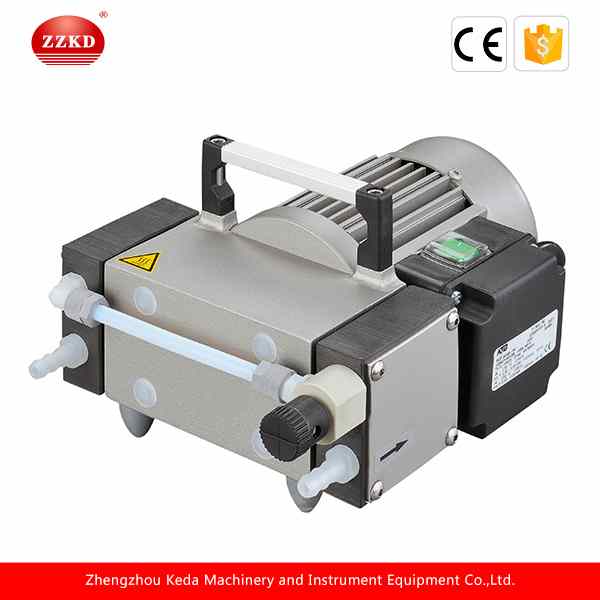What is diaphragm vacuum pump
Our best-selling diaphragm vacuum pumps include P20-2 diaphragm vacuum pump, MPC diaphragm vacuum pump and so on.
Diaphragm vacuum pump, with advanced design, high working efficiency and long service life, is a new generation product integrating high and new technology. Mainly used in medical and pharmaceutical product analysis, fine chemicals, biochemical pharmacy, food inspection, and other fields. It is a supporting product for vacuum extraction equipment and one of the necessary equipment in the laboratory.
Features of diaphragm vacuum pump:
Strong chemical corrosion resistance: The corrosion-resistant vacuum pump uses a special diaphragm (PTFE coating on the surface of the diaphragm) and pump head design, including all joints and pipelines, to ensure that the parts in contact with the gas are imported PTFE materials, so it can withstand large Part of the corrosive gas; at the same time, the electrical switches and casings are also treated with anti-corrosion treatment, especially the transmission mechanism and circuit parts are made of corrosion-resistant materials to form a closed space, which is completely isolated from the external environment, so that the vacuum pump can not only resist corrosive media, but also Suitable for corrosive environment, completely solve the problem of chemical corrosion resistance of vacuum pump;
Pollution-free and maintenance-free: Diaphragm vacuum pumps can completely recover solvents, eliminating the pollution of toxic and harmful organic solvents to the environment and the health hazards of operators and nearby personnel. Even mixed solvents can be highly recycled; diaphragm pumps are not The water- and oil-free dry pump makes the laboratory clean and quiet. Users do not need to clean, change pipes, change water and other maintenance work regularly. The diaphragm vacuum pump is 100% maintenance-free;
Low noise, low vibration: The corrosion-resistant vacuum pump adopts electric motor direct drive power transmission, no intermediate transmission parts, and the low-stroke, low-noise characteristics of the diaphragm, so the product noise can be kept below 70 decibels;
Overheating protection:Each product is equipped with a temperature protection switch. When the internal temperature of the machine body is too high, it will automatically stop, wait for the temperature to cool down and then start automatically to ensure the stability and safety of the system.
Installation steps of diaphragm vacuum pump:
1. Diaphragm vacuum pumps should be installed in a place with a solid ground, and there should be sufficient room around them to facilitate inspection, maintenance, and maintenance.
2. Keep the foundation level under the base of the diaphragm vacuum pump. It is recommended that the four corners of the base be cushioned with shock-absorbing rubber or installed with bolts to ensure smooth operation of the diaphragm vacuum pump and low vibration.
8. The connecting pipeline between the diaphragm vacuum pump and the system should be sealed and reliable. For small diaphragm vacuum pumps, metal pipelines can be used to connect the sealing gasket and use oil-resistant rubber. For small diaphragm vacuum pumps, vacuum hoses can be used for connection. The pipe diameter should not be less than the suction diameter of the diaphragm vacuum pump. And it requires short pipes and fewer elbows. (When welding the pipeline, the welding slag in the pipeline should be removed, and it is strictly forbidden to enter the diaphragm vacuum pump cavity.)
4. In the connecting pipeline, the user can install a valve and a vacuum gauge above the inlet of the diaphragm vacuum pump to check the ultimate pressure of the diaphragm vacuum pump at any time.
5. Connect the power supply according to the motor label, and connect the grounding wire and install the capacitor and thermal relay of appropriate specifications.
6. When the diaphragm vacuum pump is energized for trial operation, the motor belt must be removed to confirm that the rotation of the diaphragm vacuum pump is in accordance with the specified direction before it can be put into use to prevent the diaphragm vacuum pump from reversing fuel injection. (Turn to the direction indicated by the protective cover)
7. For diaphragm vacuum pumps with cooling water, connect the cooling water as required.
8. When a solenoid valve is installed at the port of the diaphragm vacuum pump, the valve and the diaphragm vacuum pump should operate at the same time.
9. When the exhaust gas of the diaphragm vacuum pump affects the working environment, a pipe can be installed at the exhaust port to lead away or an oil mist filter can be installed.


